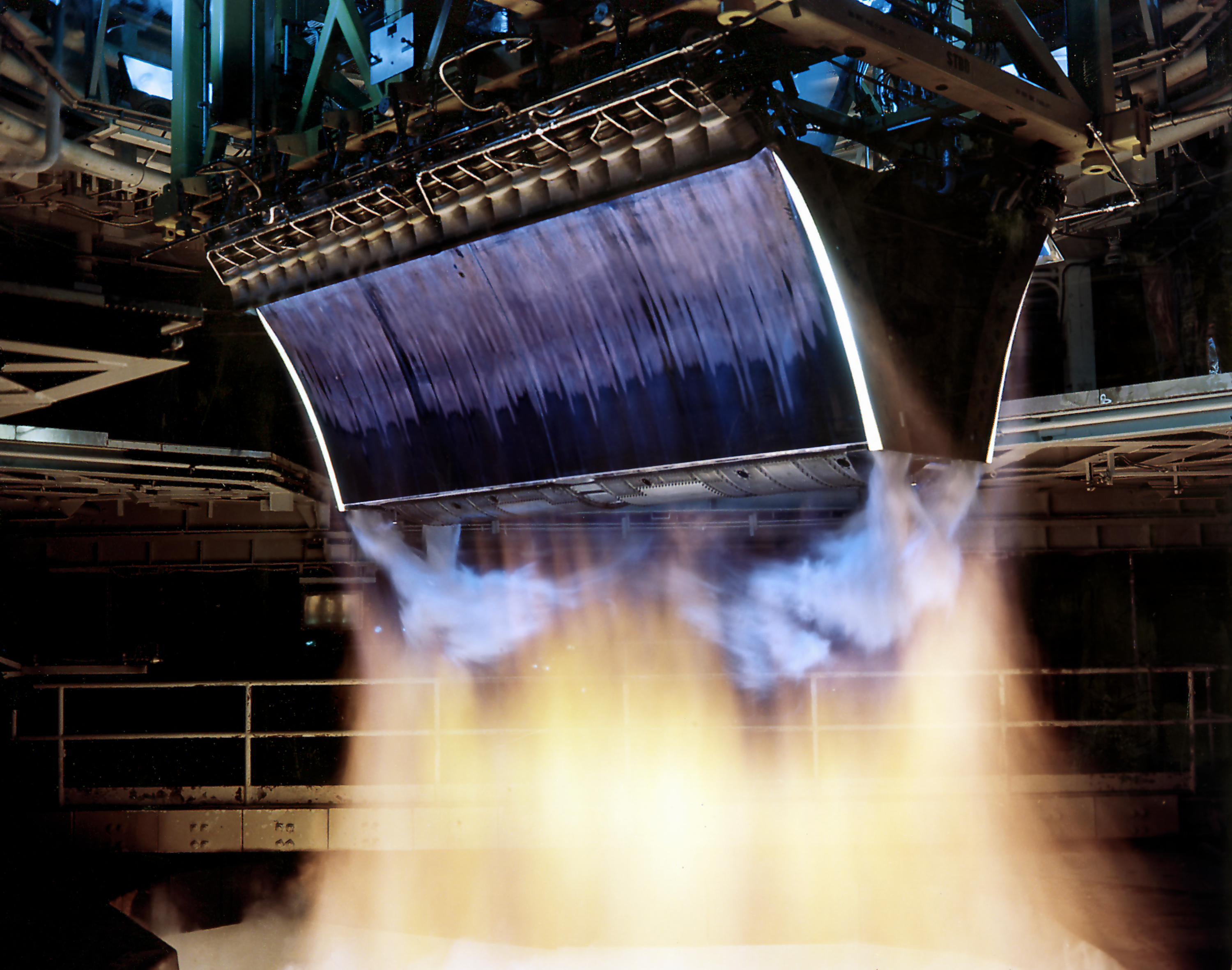|
RS-2200
The Rocketdyne RS-2200 was an experimental linear aerospike rocket engine developed by Rocketdyne for Lockheed Martin's VentureStar VentureStar was a single-stage-to-orbit reusable launch system proposed by Lockheed Martin and funded by the U.S. government. The goal was to replace the Space Shuttle by developing a re-usable spaceplane that could launch satellites into orbit a ... program. The program was ultimately cancelled in 2001 before any RS-2200 engines were assembled. XRS-2200 The XRS-2200 was a subscale testbed engine that was intended to be developed into the full-scale RS-2200. This engine, unlike its full-scale counterpart, made it to the test stand and accumulated approximately 1,600 seconds of hot-fire testing. References {{Include-NASA Rocketdyne engines Rocket engines of the United States Rocketdyne Rocket engines ... [...More Info...] [...Related Items...] OR: [Wikipedia] [Google] [Baidu] |
Aerospike Engine
The aerospike engine is a type of rocket engine that maintains its aerodynamic efficiency across a wide range of altitudes. It belongs to the class of altitude compensating nozzle engines. Aerospike engines have been studied for several years and are the baseline engines for many single-stage-to-orbit (SSTO) designs and were also a strong contender for the Space Shuttle main engine. However, no such engine is in commercial production, although some large-scale aerospikes are in testing phases. The terminology in the literature surrounding this subject is somewhat confusing—the term ''aerospike'' was originally used for a truncated plug nozzle#In rockets, plug nozzle with a very rough conical taper and some gas injection, forming an "air spike" to help make up for the absence of the plug tail. However, frequently, a full-length plug nozzle is now called an aerospike. Principles The purpose of any engine bell is to direct the exhaust of a rocket engine in one direction, generati ... [...More Info...] [...Related Items...] OR: [Wikipedia] [Google] [Baidu] |
VentureStar
VentureStar was a single-stage-to-orbit reusable launch system proposed by Lockheed Martin and funded by the U.S. government. The goal was to replace the Space Shuttle by developing a re-usable spaceplane that could launch satellites into orbit at a fraction of the cost. While the requirement was for an uncrewed launcher, it was expected to carry passengers as cargo. The VentureStar would have had a wingspan of , a length of , and would have weighed roughly 1000 t (2.2 million lb). VentureStar was intended to be a commercial single-stage-to-orbit vehicle that would be launched vertically, but return to Earth as an airplane. Flights would have been leased to NASA as needed. After failures with the X-33 subscale technology demonstrator test vehicle, funding was cancelled in 2001. VentureStar was essentially a bigger version of the X-33 but was not produced. The X-33 had ongoing problems meeting performance requirements for the carbonfibre hydrogen fuel tank. There were a number of ... [...More Info...] [...Related Items...] OR: [Wikipedia] [Google] [Baidu] |
Rocketdyne
Rocketdyne was an American rocket engine design and production company headquartered in Canoga Park, California, Canoga Park, in the western San Fernando Valley of suburban Los Angeles, California, Los Angeles, in southern California. The Rocketdyne Division was founded by North American Aviation (NAA) in 1955, and was later part of Rockwell International (1967–1996) and Boeing (1996–2005). In 2005, the Rocketdyne Division was sold to United Technologies Corporation, becoming Pratt & Whitney Rocketdyne as part of Pratt & Whitney. In 2013, Pratt & Whitney Rocketdyne was sold to GenCorp, which merged it with Aerojet to form Aerojet Rocketdyne.Marjorie Censer(18 Dec 2022) L3Harris moves to acquire Aerojet Rocketdynefor $4.7 billion, after Lockheed Martin ended its attempt for Rocketdyne in Feb 2022 History After World War II, North American Aviation (NAA) was contracted by the Defense Department to study the German V-2, V-2 missile and adapt its engine to Society of Automotiv ... [...More Info...] [...Related Items...] OR: [Wikipedia] [Google] [Baidu] |
Rocketdyne Engines
Rocketdyne was an American rocket engine design and production company headquartered in Canoga Park, in the western San Fernando Valley of suburban Los Angeles, in southern California. The Rocketdyne Division was founded by North American Aviation (NAA) in 1955, and was later part of Rockwell International (1967–1996) and Boeing (1996–2005). In 2005, the Rocketdyne Division was sold to United Technologies Corporation, becoming Pratt & Whitney Rocketdyne as part of Pratt & Whitney. In 2013, Pratt & Whitney Rocketdyne was sold to GenCorp, which merged it with Aerojet to form Aerojet Rocketdyne.Marjorie Censer(18 Dec 2022) L3Harris moves to acquire Aerojet Rocketdynefor $4.7 billion, after Lockheed Martin ended its attempt for Rocketdyne in Feb 2022 History After World War II, North American Aviation (NAA) was contracted by the Defense Department to study the German V-2 missile and adapt its engine to Society of Automotive Engineers (SAE) measurements and U.S. construction de ... [...More Info...] [...Related Items...] OR: [Wikipedia] [Google] [Baidu] |
Rocket Engine
A rocket engine uses stored rocket propellants as the reaction mass for forming a high-speed propulsive jet of fluid, usually high-temperature gas. Rocket engines are reaction engines, producing thrust by ejecting mass rearward, in accordance with Newton's third law. Most rocket engines use the combustion of reactive chemicals to supply the necessary energy, but non-combusting forms such as cold gas thrusters and nuclear thermal rockets also exist. Vehicles propelled by rocket engines are commonly called rockets. Rocket vehicles carry their own oxidiser, unlike most combustion engines, so rocket engines can be used in a vacuum to propel spacecraft and ballistic missiles. Compared to other types of jet engine, rocket engines are the lightest and have the highest thrust, but are the least propellant-efficient (they have the lowest specific impulse). The ideal exhaust is hydrogen, the lightest of all elements, but chemical rockets produce a mix of heavier species, reducing the e ... [...More Info...] [...Related Items...] OR: [Wikipedia] [Google] [Baidu] |
Lockheed Martin
The Lockheed Martin Corporation is an American aerospace, arms, defense, information security, and technology corporation with worldwide interests. It was formed by the merger of Lockheed Corporation with Martin Marietta in March 1995. It is headquartered in North Bethesda, Maryland, in the Washington, D.C. area. Lockheed Martin employs approximately 115,000 employees worldwide, including about 60,000 engineers and scientists as of January 2022. Lockheed Martin is one of the largest companies in the aerospace, military support, security, and technologies industry. It is the world's largest defense contractor by revenue for fiscal year 2014.POC Top 20 Defence Contractors of 2014 . Retrieved: July 2015 In 2013, 78% of Lockheed Martin's revenues came from military sales; [...More Info...] [...Related Items...] OR: [Wikipedia] [Google] [Baidu] |
NASA Headquarters
NASA Headquarters, officially known as Mary W. Jackson NASA Headquarters or NASA HQ and formerly named Two Independence Square, is a low-rise office building in the two-building Independence Square complex at 300 E Street SW in Washington, D.C. The building houses NASA leadership who provide overall guidance and direction to the US government executive branch agency NASA, under the leadership of the NASA administrator. Ten field centers and a variety of installations around the country conduct the day-to-day work. NASA Headquarters is organized into four Mission Directorates: Aeronautics, Exploration Systems, Science, and Space Operations. The James E. Webb Memorial Auditorium, named for NASA's second administrator James E. Webb, hosts agency news conferences and NASA Social events. A lending library, the history office, archives, production facilities for NASA TV, and a NASA gift shop are also housed in the building. The building, which opened in 1992, was designed by Kohn Ped ... [...More Info...] [...Related Items...] OR: [Wikipedia] [Google] [Baidu] |
Encyclopedia Astronautica
The ''Encyclopedia Astronautica'' is a reference web site on space travel. A comprehensive catalog of vehicles, technology, astronauts, and flights, it includes information from most countries that have had an active rocket research program, from Robert Goddard to the NASA Space Shuttle and the Soviet Buran programme. Founded in 1994 and maintained for most of its existence by space enthusiast and author Mark Wade. He has been collecting such information for most of his life. Between 1996 and 2000 the site was hosted by ''Friends and Partners in Space''. The site is no longer updated or maintained and is now considered as partially unreliable. Although it contains a great deal of information, not all of it is correct. Reception and accolades The American Astronautical Society gave the site the Ordway Award for Sustained Excellence in Spaceflight History which "recognizes exceptional, sustained efforts to inform and educate on spaceflight and its history through one or more med ... [...More Info...] [...Related Items...] OR: [Wikipedia] [Google] [Baidu] |
Rocket Engines Of The United States
A rocket (from it, rocchetto, , bobbin/spool) is a vehicle that uses jet propulsion to accelerate without using the surrounding air. A rocket engine produces thrust by reaction to exhaust expelled at high speed. Rocket engines work entirely from propellant carried within the vehicle; therefore a rocket can fly in the vacuum of space. Rockets work more efficiently in a vacuum and incur a loss of thrust due to the opposing pressure of the atmosphere. Multistage rockets are capable of attaining escape velocity from Earth and therefore can achieve unlimited maximum altitude. Compared with airbreathing engines, rockets are lightweight and powerful and capable of generating large accelerations. To control their flight, rockets rely on momentum, airfoils, auxiliary reaction engines, gimballed thrust, momentum wheels, deflection of the exhaust stream, propellant flow, spin, or gravity. Rockets for military and recreational uses date back to at least 13th-century China. Significant ... [...More Info...] [...Related Items...] OR: [Wikipedia] [Google] [Baidu] |




